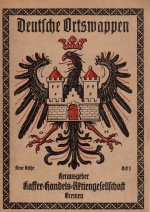Coffee Hag albums
| Heraldry of the World Heraldic collector's items catalogue > Heraldic albums |
Introduction
In the early 20th century the Kaffee Handelsgesellschaft AG (Kaffee HAG) in Bremen, Germany, started with the publication of heraldic stamps and collector's albums.
The stamps and books were published as a result of the initiative of the Brücke association. This was an initiative of Emperor Wilhelm II to make an archive of published material. At the same time the association developed standard sizes for publishing material. To promote their activities and their new standards, they encouraged companies to publish material in their standards. The Kaffee Hag company was one of the companies that agreed to do so. Hence the stamps are published in the so-called Weltformat V der Brücke (or 4 x 5,66 cm), which is also printed on the back of the stamps. The albums were published in the Weltformat IX (16 x 22.6 cm). The association went bankrupt in 1913 and abolished in 1914, but the size of the stamps remained the same for all the albums.
Only on the German and Swiss stamps there was the reference to the Weltformat.
The company hired the famous artist Otto Hupp to design the stamps. Otto Hupp already published several well known volumes on German civic heraldry since the 1890s.
The albums became a success in Germany and the company exported the idea to the other European countries in which the company operated.
Two series, Germany and Switzerland, were started before World War I and were never finished. In the 1920s and 1930s the second series of these countries as well as the other countries were launched. In each country different heraldic artists were used to write the albums and draw the images.
In total around 125 different albums were published between 1914-1955. Albums for the Baltic states, Italy as well as a second album for Poland and an 11th for Germany were planned, but never issued. The French series stopped after 6 albums of the planned 40.

